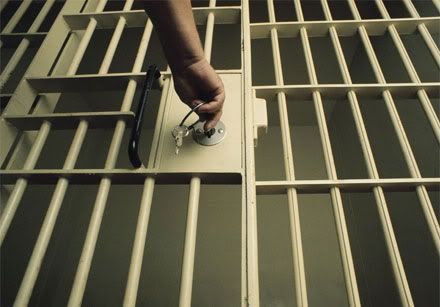Prison system theoretically ahead of North Carolina
 In case you aren't familiar with it, PREA is the Prison Rape Elimination Act of 2003.
In case you aren't familiar with it, PREA is the Prison Rape Elimination Act of 2003.
The National PREA Resource Center has clarified guidelines set in 2012 regarding the treatment of transgender inmates within the prison system, stating Thursday that any policy that houses transgender or intersex inmates based exclusively on external genital anatomy violates PREA standards.
Standard 115.42(c): In deciding whether to assign a transgender or intersex inmate to a facility for male or female inmates, and in making other housing and programming assignments, the agency shall consider on a case-by-case basis whether a placement would ensure the inmate’s health and safety, and whether the placement would present management or security problems.
(e) A transgender or intersex inmate’s own views with respect to his or her own safety shall be given serious consideration.
Think about that: This is a better situation than transgender people are facing in North Carolina in regards to restrooms usage.
The clarification:Being transgender is a known risk factor for being sexually victimized in confinement settings. The standard, therefore, requires that facility, housing, and programming assignments be made “on a case-by-case basis.” Any written policy or actual practice that assigns transgender or intersex inmates to gender-specific facilities, housing units, or programs based solely on their external genital anatomy violates the standard. A PREA-compliant policy must require an individualized assessment. A policy must give “serious consideration” to transgender or intersex inmates’ own views with respect to safety. The assessment, therefore, must consider the transgender or intersex inmate’s gender identity – that is, if the inmate self-identifies as either male or female. A policy may also consider an inmate’s security threat level, criminal and disciplinary history, current gender expression, medical and mental health information, vulnerability to sexual victimization, and likelihood of perpetrating abuse. The policy will likely consider facility-specific factors as well, including inmate populations, staffing patterns, and physical layouts. The policy must allow for housing by gender identity when appropriate.
A survey conducted by the federal Bureau of Justice Statistics in 2011 and 2012 estimated that 4 percent of state and federal prison inmates and 3 percent of jail inmates reported being sexually assaulted by other inmates or staff in the previous year. But more than a third of transgender inmates in prisons and a third in jails said they had been sexually assaulted during the same time period. Transgender women housed in men's prisons are at even greater risk for sexual assault. A California study found that nearly 60 percent of transgender women inmates housed in men's prisons reported being sexually assaulted, compared to just 4 percent of non-transgender inmates in men's prison. The BJS estimates that there are 3,200 transgender inmates in US prisons and jails.
Advocates have long been pushing for this clarification in order to make agencies take seriously the health and wellbeing of transgender people in their care.
Human Rights Watch and a coalition of immigrant rights organizations on Wednesday released a 68-page document entitled Do You See How Much I’m Suffering Here: Abuse Against Transgender Women in U.S. Immigration Detention which demonstrates that ICE is doing worse than the rest of the prison industrial complex.''
Transgender women fleeing abuse in their home countries who seek asylum in the United States have been sexually assaulted, denied medical care and held in indefinite solitary confinement in prison-like detention facilities, according to a report released Wednesday.
In essence, many transgender women have simply traded one set of abusive conditions for another.
--the report
The study is based on 28 interviews with transgender women, mainly from Mexico and Central America, who were held from 2011 to 2015 in facilities across the country — mostly in Southern California. The detainees said they were unnecessarily strip-searched by male guards, denied HIV medication and were ignored by immigration officials after reporting sexual assault by other detainees.
Here in Southern California, most transgender detainees are housed at Santa Ana Jail, which has a separate wing for transgender inmates. While that provides some protection from other detainees, it does not provide protection from the "guards."
Invasive strip searches, frequent lockdowns that involve cell confinement for up to 24 hours a day and inadequate medical and mental health services are the norm, the report stated.


Comments
Wow.
So about two weeks ago
I was ordering something bad for me at a McDonald's and a pretty, young woman who I'm reasonably certain was trans ordered behind me. Granted, both the youth and the general attractiveness probably make that an edge case but the idea that anyone in their right mind would throw her into a confinement situation with a bunch of males is beyond ludicrous. No wait... the word I was searching for is barbaric.
The fact that prison systems apparently are handling this better than the North Carolina legislature is a mockery.
A lot of wanderers in the U.S. political desert recognize that all the duopoly has to offer is a choice of mirages. Come, let us trudge towards empty expanse of sand #1, littered with the bleached bones of Deaniacs and Hope and Changers.
-- lotlizard
Thank you, Robyn
Glad to see you here.
Thanks for this post
...& your ceaseless effort to draw attention to these issues.
Good commentary at The Nation
that gets to the root of the issue -- the bathroom laws are merely an attempt to deny transgender individuals their right to exist in society without coming out and outright banning the procedures.
http://www.thenation.com/article/the-ugly-fantasy-at-the-heart-of-anti-t...